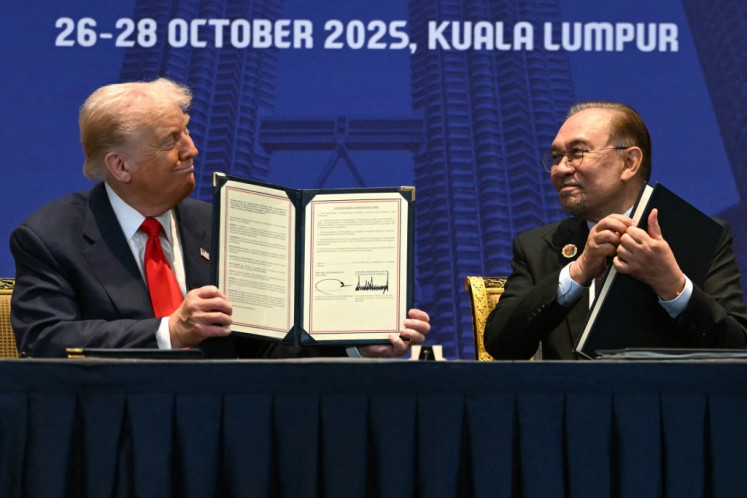Popular Reads
Top Results
Can't find what you're looking for?
View all search resultsPopular Reads
Top Results
Can't find what you're looking for?
View all search resultsRethinking new town development with high-speed rail
Following the groundbreaking by President Joko âJokowiâ Widodo last month, Jakarta and Bandung have moved a step closer to having the fastest train connection in Indonesia
Change text size
Gift Premium Articles
to Anyone
F
ollowing the groundbreaking by President Joko 'Jokowi' Widodo last month, Jakarta and Bandung have moved a step closer to having the fastest train connection in Indonesia. Despite its controversial nature, it is undoubtedly true that high-speed rail opens up new opportunities.
Although it is not certain whether the flagship project will go into the construction and then operation phases, master plans of new towns along the railway have gone public and raised many questions. Will we use the same approach in developing new towns that we have used so far? Sprawling and extravagantly wasting natural resources and green fields? Why don't we opt for a more compact and efficient approach?
Public awareness of urban issues in Indonesia, particularly in Jakarta, is now higher than before. More attention and focus are being concentrated on urban quality issues such as pedestrian rights, child-friendly public spaces, transit-oriented development and river revitalization.
This positive attitude serves as a reminder that creating a better urban environment for citizens in cities in Indonesia remains a long-term but achievable goal.
Lack of well-designed pedestrian sidewalks, inadequate green open space and a car-dominated environment are some shortcomings to which we are still working out the solutions.
Urban quality issues need not only adequate funding and expertise but also strong political will as it has to come into play to ease and speed up the changes.
In the meantime, while most cities around the world are trying to reduce sprawl, new developments in Indonesia keep expanding beyond control and eating up vast amounts of green open space.
These expansive new developments are horizontal and single-use, rather than vertical and multi-use. For that reason, this green field-consuming development should be minimized and restricted.
In an urban environment with taller buildings and higher density, convenient access to various modes of mass transportation is important.
However, high-speed rail alone will not be enough to develop compact communities as good accessibility should be maintained down to the neighborhood level.
The Jakarta-Bandung high-speed rail has been a contentious issue since its inception. People have asked many questions and raised concerns, particularly about the budget, the frantic environmental impact assessment process, earthquake resistance, as it will cross at least four fault lines, as well as why it will only go as far as Bandung.
Although Presidential Decree No. 107/2015 states that project costs will not be covered by the state budget, the government, through its ministries, still needs to make great efforts to realize the project, particularly in terms of land acquisition and spatial plan adjustments. With all the pros and cons and no construction permits yet from the Ministry of Transportation, no wonder a lot of people have expressed doubts about the prospects of the project.
It is worth looking at some other high-speed rail projects such as the High Speed 2 (HS2) project in the UK. First announced in 2010, it was originally planned to provide better connectivity and cut travel time from London to other major UK cities, such as Birmingham, Manchester and others in the central and northern part of the UK.
The UK government says that HS2 will relieve congestion on commuter routes by redirecting millions of travelers who would otherwise fly or drive.
Urban quality issues need not only adequate funding and expertise but also strong political will.
However, it has upset many people because the rail line cuts through open and serene countryside rather than running near busy roads.
The scheme has been in the planning stage for seven years as further studies have to be carried out regarding the effects of the HS2 on the UK economy and its phase two rail alignment.
In short, a lot of parties are skeptical about the plan due to the skyrocketing environmental and social costs, and believe that HS2 will not take the burden off London or bring significant benefits to the other cities.
Infrastructure projects will improve our economy, but if we don't plan them wisely, we will end up with greater losses. There is no denying the fact that Indonesia still has vast tracts of undeveloped land, but the city itself has limits, such as size and service coverage, and indeed should be limited.
One way to limit urban encroachment is to reuse and regenerate underutilized land and abandoned plots, instead of converting green space.
Converting these spaces into mixed-use and denser developments with a well-integrated transport system is the next step to maximize the city's capacity. The Compact City concept should be central to urban planning at present and into the future if we do not want to lose an excessive amount of our natural assets.
A compact city, as a renowned Italian-British architect, Richard Rogers, points out in his book 'Cities for A Small Planet', is a 'dense and socially diverse city where economic and social activities overlap and where communities are focused around neighborhoods'. It is essential for a compact city to grow around its social and commercial centers at public transport nodes. This concept
If it is already too late to implement such a model in Jakarta or other big cities, this concept could be useful as a fundamental basis for controlling the development of new towns or smaller cities.
It is true that high-speed rail will boost the economy and create more jobs, but are we ready to handle such massive new developments while still struggling with problems in our big cities at present? The fact that we have not been able to solve urban quality issues and develop our own people-friendly, compact cities should be the main concern when we consider the building of new towns.
The question is, does high-speed rail create more problems than it solves?
_______________
The writer is an urban designer working at a multinational built environment consultancy in Jakarta.










